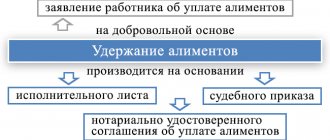Home / Family law / Alimony
Back
Published: 02/16/2018
Reading time: 7 min
0
302
The life and financial circumstances of the recipient and payer of alimony may change significantly, in which case an adjustment to the amount of the payment is required. The ability to change the payment amount depends on the ability to prove the need for such a change.
- Legislative regulation
- In what cases is change possible?
- The necessary conditions
- Algorithm for changing the amount of alimony Required documents
- Required information
Legislative regulation
The change in monthly payment is regulated by:
- Family Code;
- Civil Procedure Code.
Art. 119 of the RF IC indicates the judicial procedure for changing the amount of alimony, and Art. 131 of the Code of Civil Procedure of the Russian Federation determines the content of the statement of claim.
As a rule, a claim to increase alimony is filed by the recipient, and a claim to reduce the amount is filed by the payer.
The procedure for change in both cases is the same - the court evaluates the circumstances that prompted the filing of the claim and makes a decision.
Art. 101 of the RF IC states that changing the amount of alimony by agreement without filing a lawsuit is possible only if the current payment was also assigned without a trial - by agreement.
Transfer of alimony to a fixed sum of money from a share of the payer’s income
Judicial practice shows that most alimony collected by court decision is calculated based on the percentage of the payer’s income provided for in Article 81 of the RF IC. If a lawsuit is subsequently filed to change the amount of alimony upward or downward, the court makes a decision by changing the recovered percentage of income, without replacing it with a fixed amount.
If the recipient claims that the payer receives unofficial wages from which collection is not made, the court must submit documents confirming the suspicions that have arisen.
In what cases is change possible?
An increase in alimony is possible in the following cases:
- increasing the cost of living for children in the region;
- the appearance of a second child for the recipient of alimony;
- the occurrence of a disease in children that requires expensive treatment;
- obtaining disabled status by one of the family members;
- loss of ability to work of the payee or another family member participating in the general budget;
- admission of a child to a paid educational institution;
- a sharp increase in the payer's income.
The payment can be increased with the growth of the payer's income only if the current payment amount is clearly insufficient and was accepted based on the difficult circumstances of the payer.
It is important to take into account that inflationary price fluctuations and increased current expenses are not grounds for increasing the alimony payment - these changes are taken into account only when the cost of living increases.
A payment reduction is permissible under the following circumstances:
- restoration of working capacity of the recipient's family members;
- drop in payer's income;
- the payer has additional family obligations;
- significant deterioration in the payer’s health and loss of ability to work;
- the absence of the payer at the meeting when determining the amount of alimony for a good reason.
Family obligations include the birth of a child and the appearance of an additional disabled dependent. You should know that the appearance of loans is not a valid reason for reducing alimony, with the exception of a mortgage to improve the living conditions of the payer’s children in a new family.
Lawyer's answers to private questions
Is it possible to change the procedure for collecting alimony for a former spouse from a fixed amount to a share of the salary?
No. Payments to spouses and former spouses are assigned only in a fixed amount of money (Article 91 of the RF IC).
At what point does the procedure for collecting alimony change after the court makes a decision?
From the moment the plaintiff goes to court, if his demands are satisfied.
Is it possible to submit an application to change the procedure for collecting alimony online?
Yes, through the State Automated System “Justice”. You can log in through State Services. The service is available to users with verified accounts.
Can I change the procedure for collecting payments for a child if I previously paid a fixed amount, but have now retired and want to ask to switch to shares?
Yes. The court will take into account the financial situation of the parties. If the result is positive, one person will be assigned 1/4 of all income, including pensions.
What income is taken into account if the court changes the procedure for collecting alimony to shared?
Alimony in the form of shares is paid from all types of income specified in the Decree of the Government of the Russian Federation of July 18, 1996 N 841 “On the list of types of wages...”. For example, this includes pensions (except for the loss of a survivor), military allowances, salaries under employment contracts, income under civil contracts.
The necessary conditions
In order for the court to change the amount of payment at the request of the plaintiff, the following conditions must be met:
- significant deterioration in the financial situation;
- availability of supporting documents;
- absence of facts of illegal actions against the payer.
It is necessary that the financial situation in the family of the plaintiff demanding a change in the amount of alimony changes so much that the plaintiff cannot cope with the solution of the problem on his own. Often, one of the conditions for reducing the amount of alimony is that the payer does not own real estate, except for that used for living or receiving rental income.
If the claim is filed by the payer, then he must have no payment arrears.
How is alimony collected?
Alimony can be collected in one of three ways:
- In a fixed (fixed) amount.
- As a percentage of income.
- In a combined form, combining the two previous methods.
As mentioned above, the procedure for calculating and paying alimony can be established by a peaceful agreement between the parties or by decision of the judicial authorities. An agreement to pay alimony is always drawn up in writing and must be notarized. Otherwise, it will not have legal force.
If the parties are unable to reach an agreement on their own, they must go to court. After considering all existing circumstances, the court will determine the optimal amount and method of collecting alimony in accordance with the norms of current legislation.
Collection in a fixed amount is possible if the alimony payer:
- receives income in the currency of another state;
- receives income in kind;
- not working (officially unemployed);
- has seasonal work;
- receives unstable wages;
- has unofficial sources of income.
The amount of alimony in a fixed amount is established in accordance with the subsistence level of the region of residence of the alimony recipient.
A combined method of paying alimony is established in exceptional cases. For example, if the payer receives a permanent income and additionally has seasonal part-time work.
To change the method of payment of alimony, it is necessary to provide the court with compelling arguments and justify why payments should be transferred in a fixed amount. For example, when a person receives a stable salary, alimony will be collected as a percentage of the salary.
Algorithm for changing the amount of alimony
In general, the procedure for changing the payment amount occurs in the following order:
- Collection of documents and preparation of a statement of claim.
- Filing an application to the court.
- Conducting a pre-trial investigation (1 month).
- Conducting a court hearing and making a decision.
- Obtaining a court decision and writ of execution.
- Sending the writ of execution to the payer’s place of work or to the bailiff.
You should know that an increase in alimony associated with a change in the cost of living (indexation) is carried out by the employer or bailiff independently without a court decision (Article 117 of the RF IC).
Required documents
The required documents to file a claim include the following:
- a copy of the plaintiff's passport;
- agreement on payment of alimony in the current amount (if any);
- certificate of family composition from the registry office;
- certificate of divorce;
- birth certificates of all children in whose favor alimony is sent (or passports of adult disabled recipients);
- a certificate from the building management about the persons registered in the apartment;
- receipt of payment of state duty;
- documents proving a change in the plaintiff’s financial situation for the worse;
- a copy of the written proposal to the defendant to change the amount of payment.
The last document is needed only if the current amount of alimony was established by voluntary agreement.
It is important to note that upon receipt of a certificate from the house management, they may be required to repay all debts for utilities.
Documents proving the plaintiff’s predicament include:
- income certificate;
- certificate of disability or illness of a family member;
- birth certificate of a new child;
- a certificate from the educational institution confirming the enrollment of the child in whose favor alimony is being collected;
- death certificate of the breadwinner.
After preparing all the documents, a statement is written outlining a request to the court to change the amount of payment.
Required information
And the following data is provided:
- name of the judicial body and full name of the judge;
- Full name, address and passport details of the plaintiff;
- Full name, date of birth and address of the defendant;
- Full name of minor children or other persons in whose favor alimony is being collected;
- current payment amount;
- circumstances of filing the claim;
- information about pre-trial actions (if alimony is paid by agreement);
- required amount of alimony.
A sample application is here.
During the pre-trial investigation, the judge summons the plaintiff and the defendant, and also checks the evidence presented in the case. When making a decision, the court is guided by the financial situation and degree of need of each party. Priority is given to the party raising minor children or supporting disabled dependents.
The court may decide to change the form of payment calculation from a fixed payment to a percentage of salary (if the payer’s income increases).
Upon decision, the basis for changing the amount of payments is the executive document.
If the plot is suitable for the landlord, then he will be interested in learning how to register ownership of the land if it is leased.
What is an apartment card and where can I get it? Find out about it here.
Are you planning to buy an apartment? You can find out in detail all the information about this type of real estate in our article.
Why is indexing needed?
Why is indexation of alimony necessary and how is it carried out? As we mentioned above, the change in payments is associated with an increase in child support costs. And if one of the parents does not have enough funds, then the second of them must increase the amount of their assistance , since both mother and father take part in providing for the child.
The amount of alimony can be changed, in accordance with Article 117 of the RF IC, based on the indexation of indicators of the children's subsistence level in the region or in the country as a whole.
If the region of residence of the payer and recipient of funds has established the amount of the minimum level of residence for a child, then the amount of alimony will be determined based on this indicator. If there are no minimum subsistence levels in the region, the average for the country as a whole is used for calculations.
General information about the procedure for indexing alimony is described in a separate article prepared by the editors of the site.
It is worth noting that under certain circumstances, there may be a decrease rather than an increase in the monthly allowance. So, for example, if the payer has a disability, dependents, or his child began working at the age of 16, then the alimony payer has the right to reduce the amount of alimony.
Deadlines and costs
Major expenses include:
- certificate from the registry office - 200 rubles;
- legal services – 3000-30000 rubles (depending on the region);
- State duty – 300 rubles.
The pre-trial investigation takes 1 month, and the court decision comes into force 10 days after the hearing. Preparing documents and obtaining a refusal from the defendant to voluntarily change the amount of payment may take 1-3 weeks. The total duration of the case is 2 months, unless the defendant appeals the verdict.









